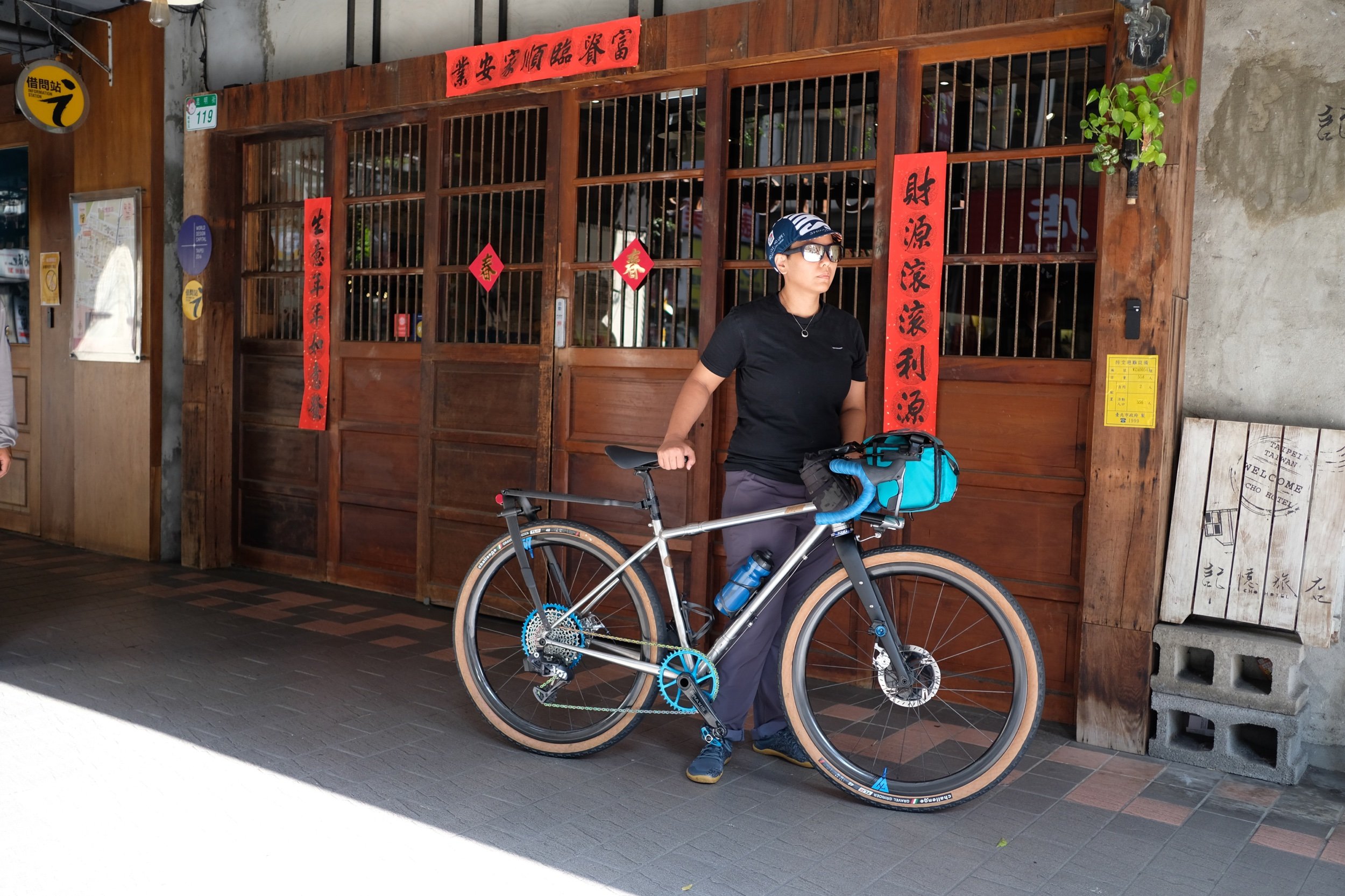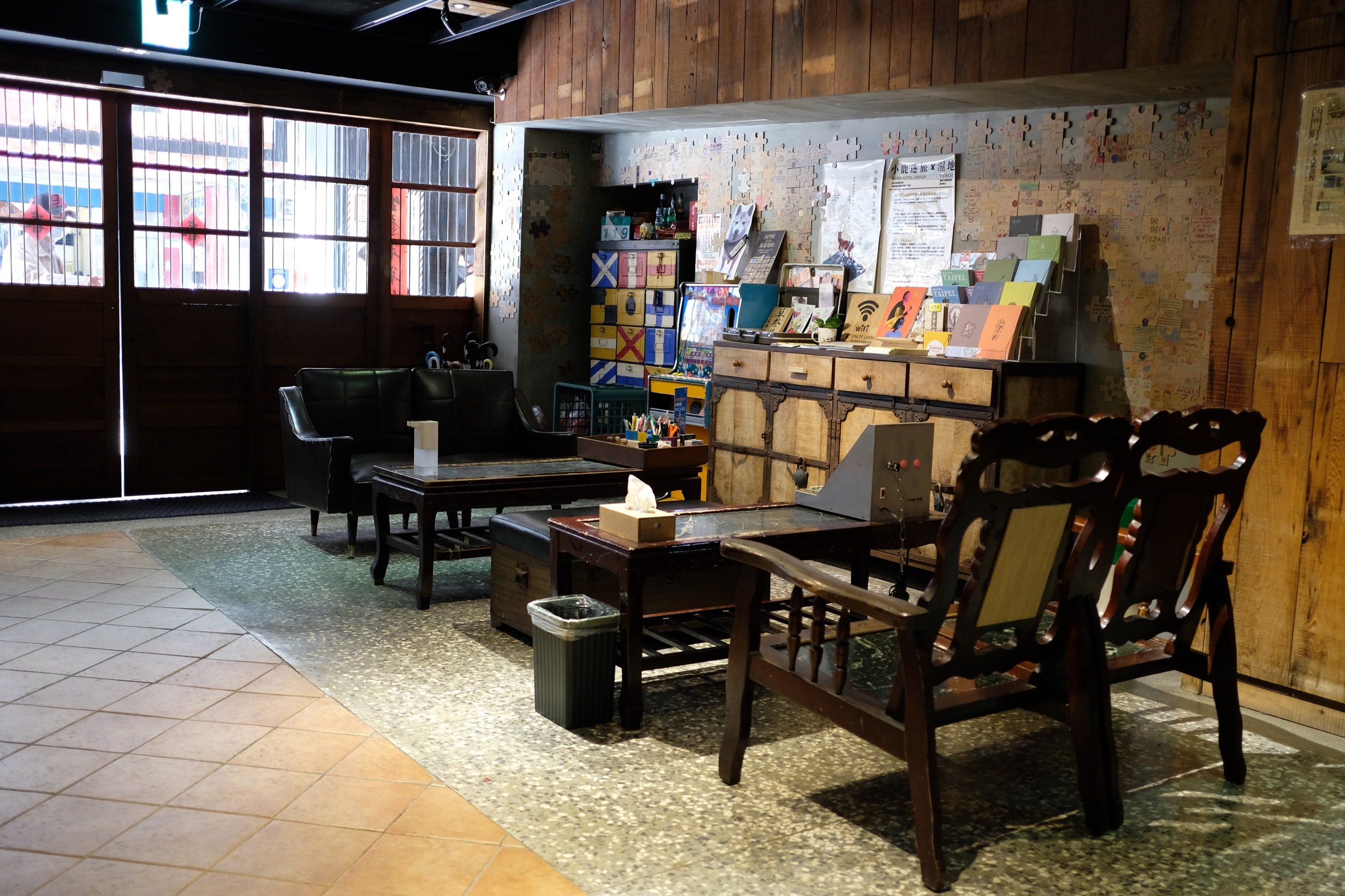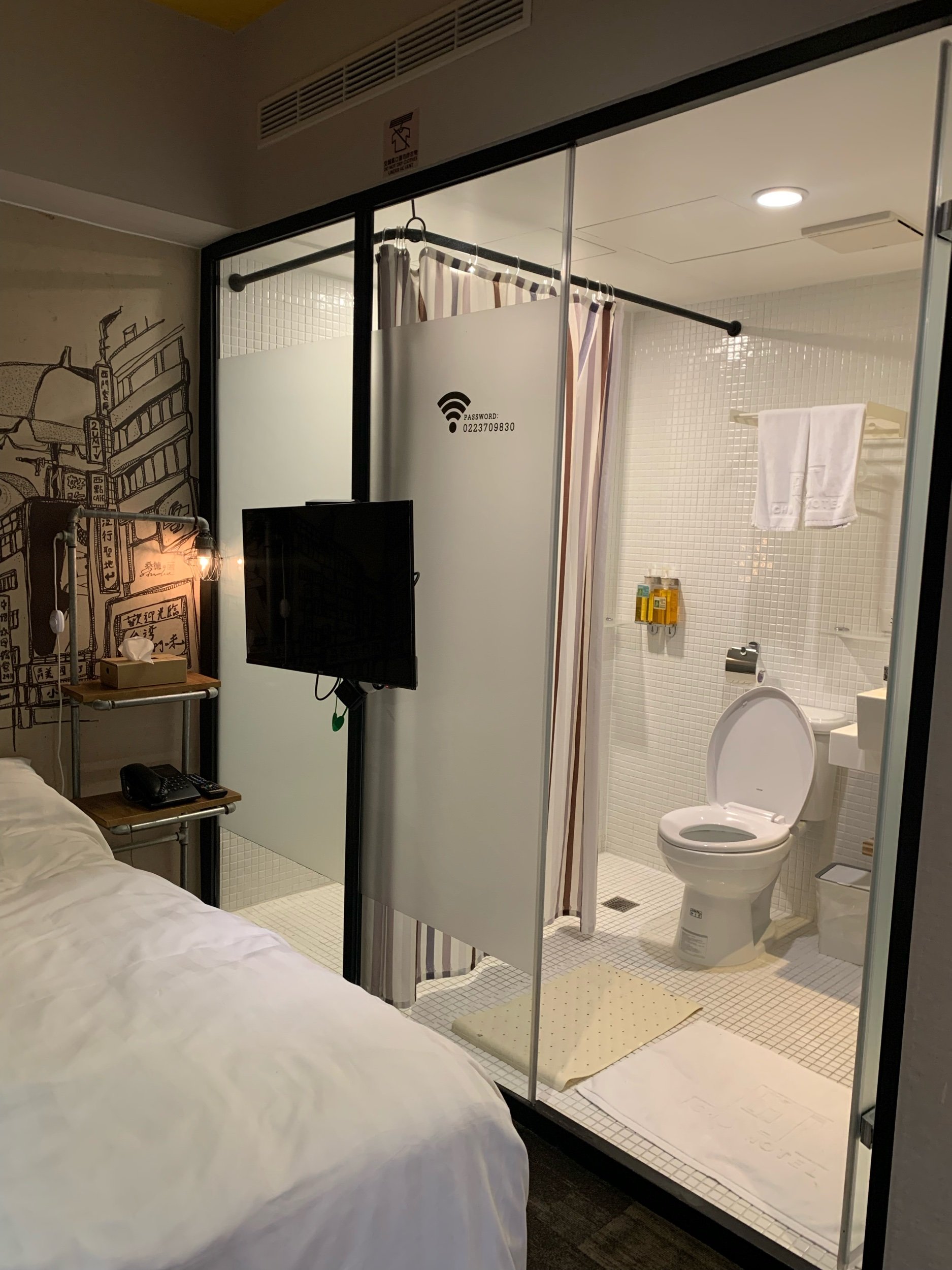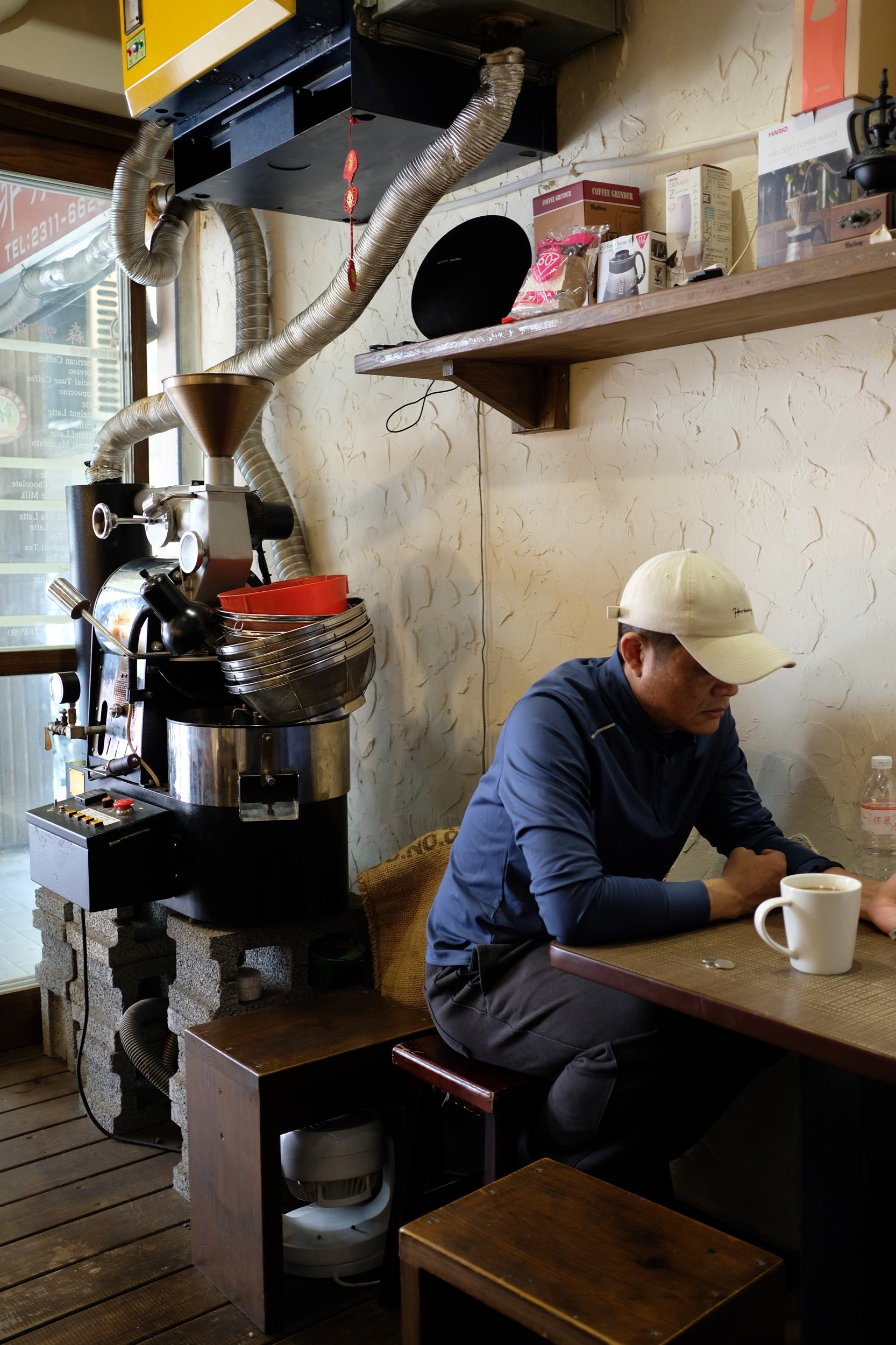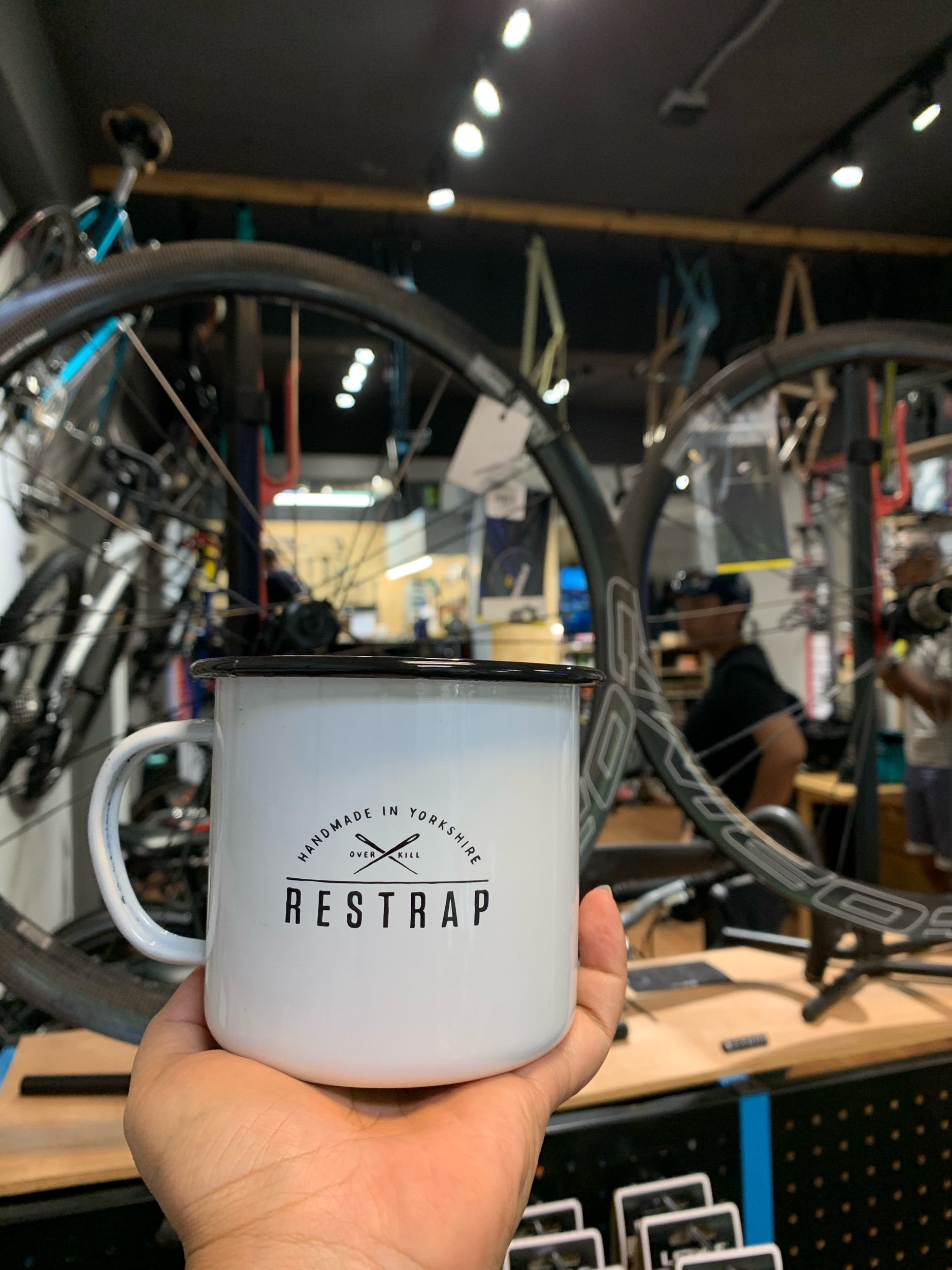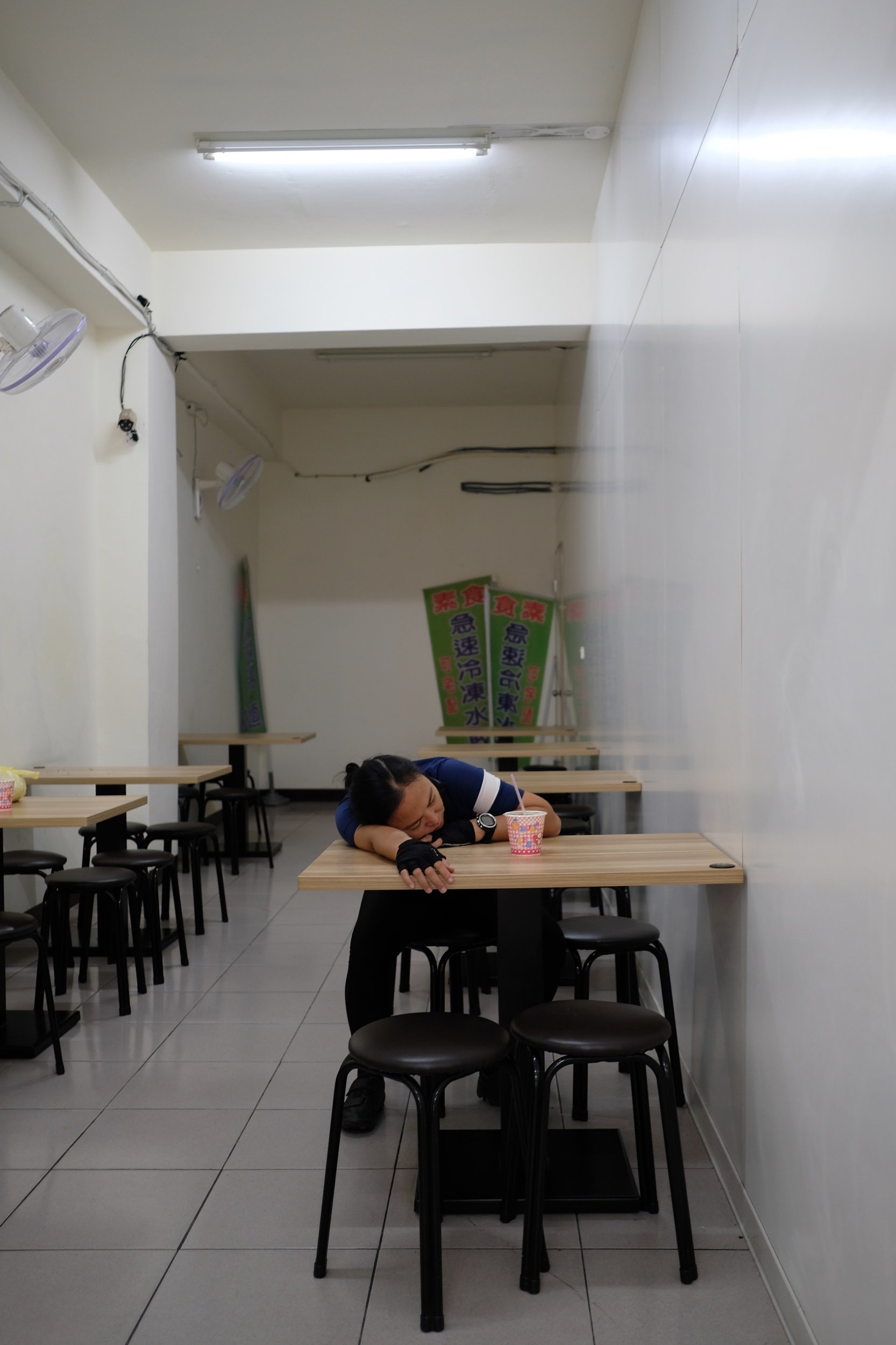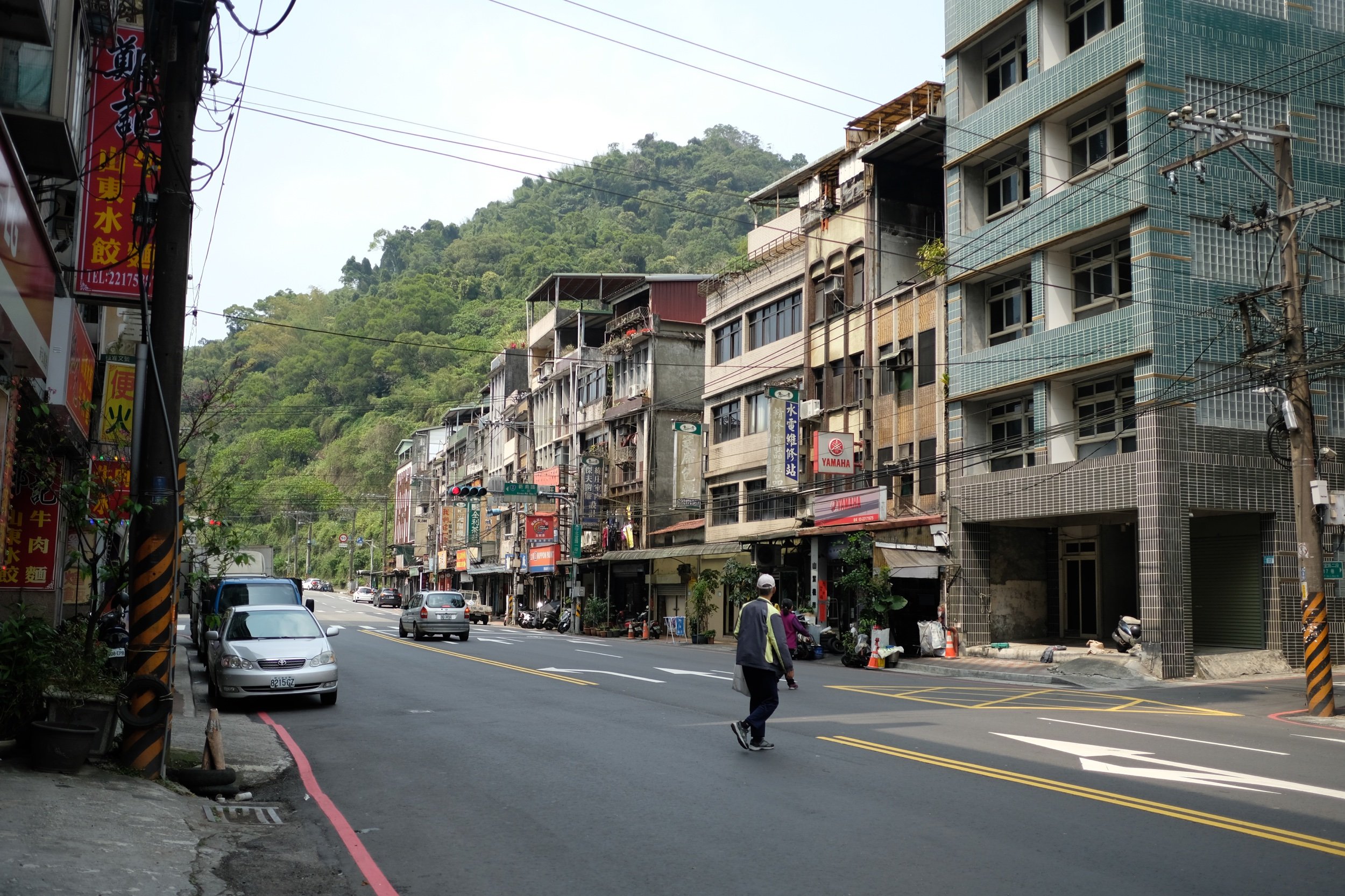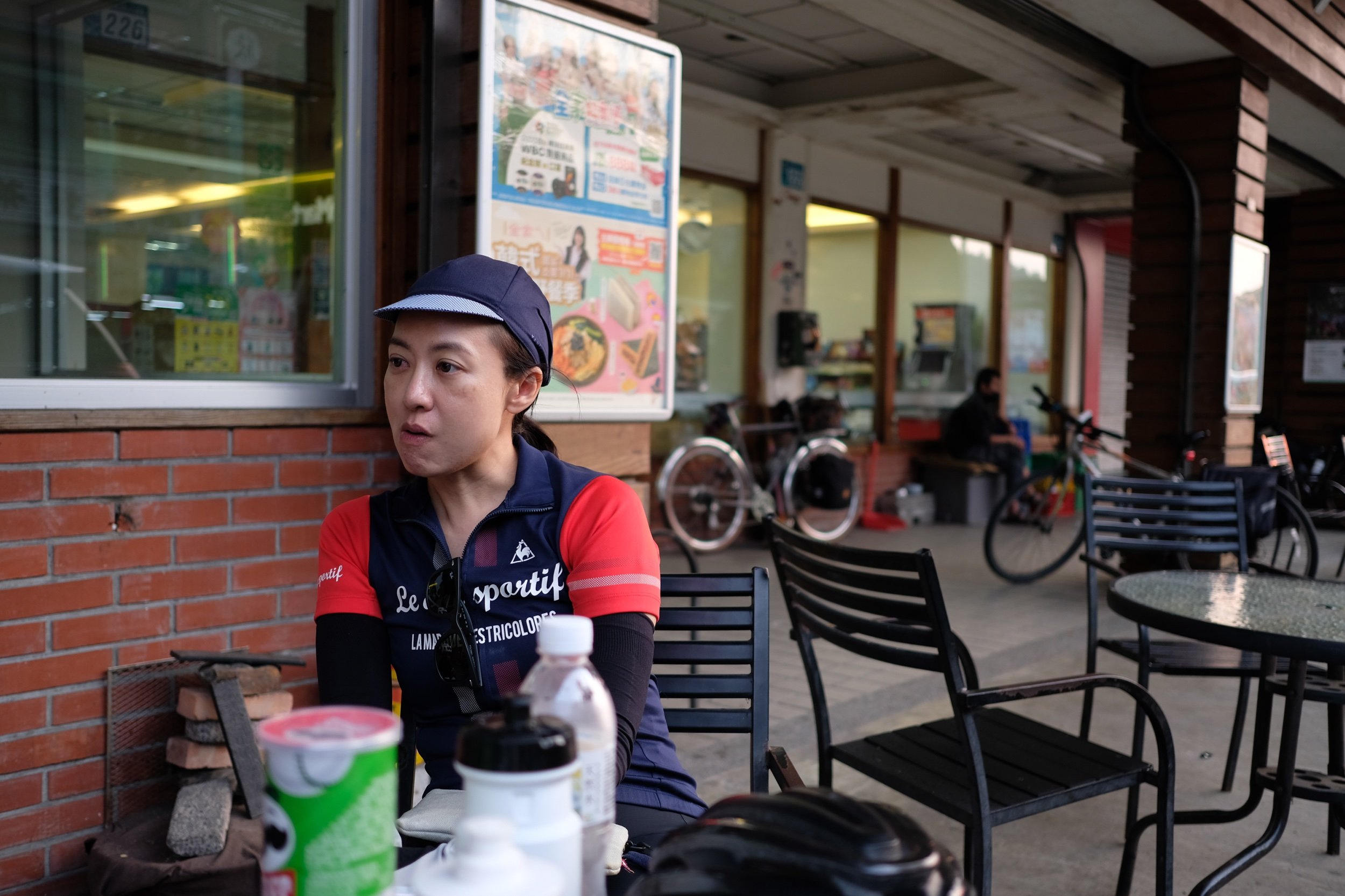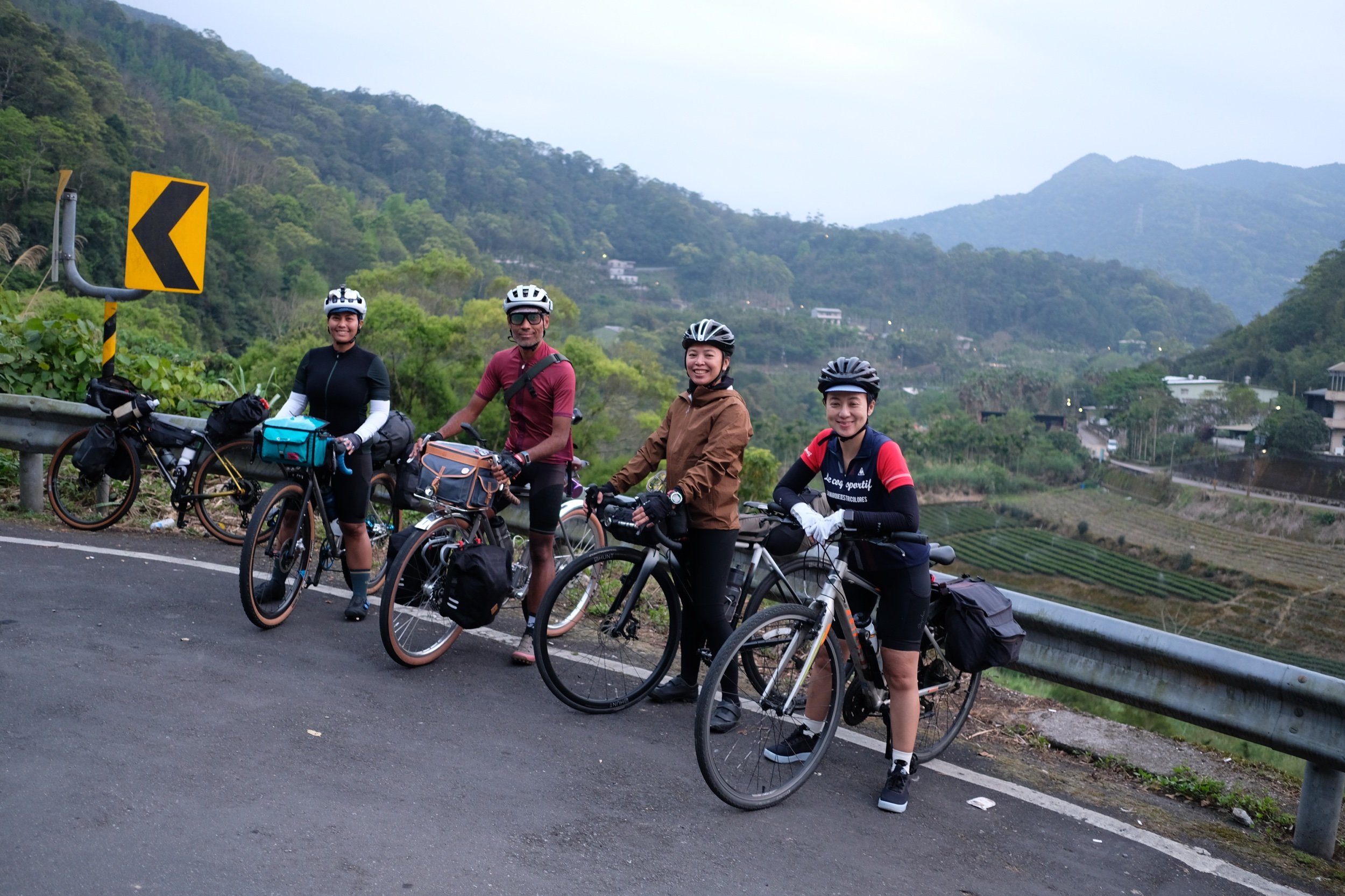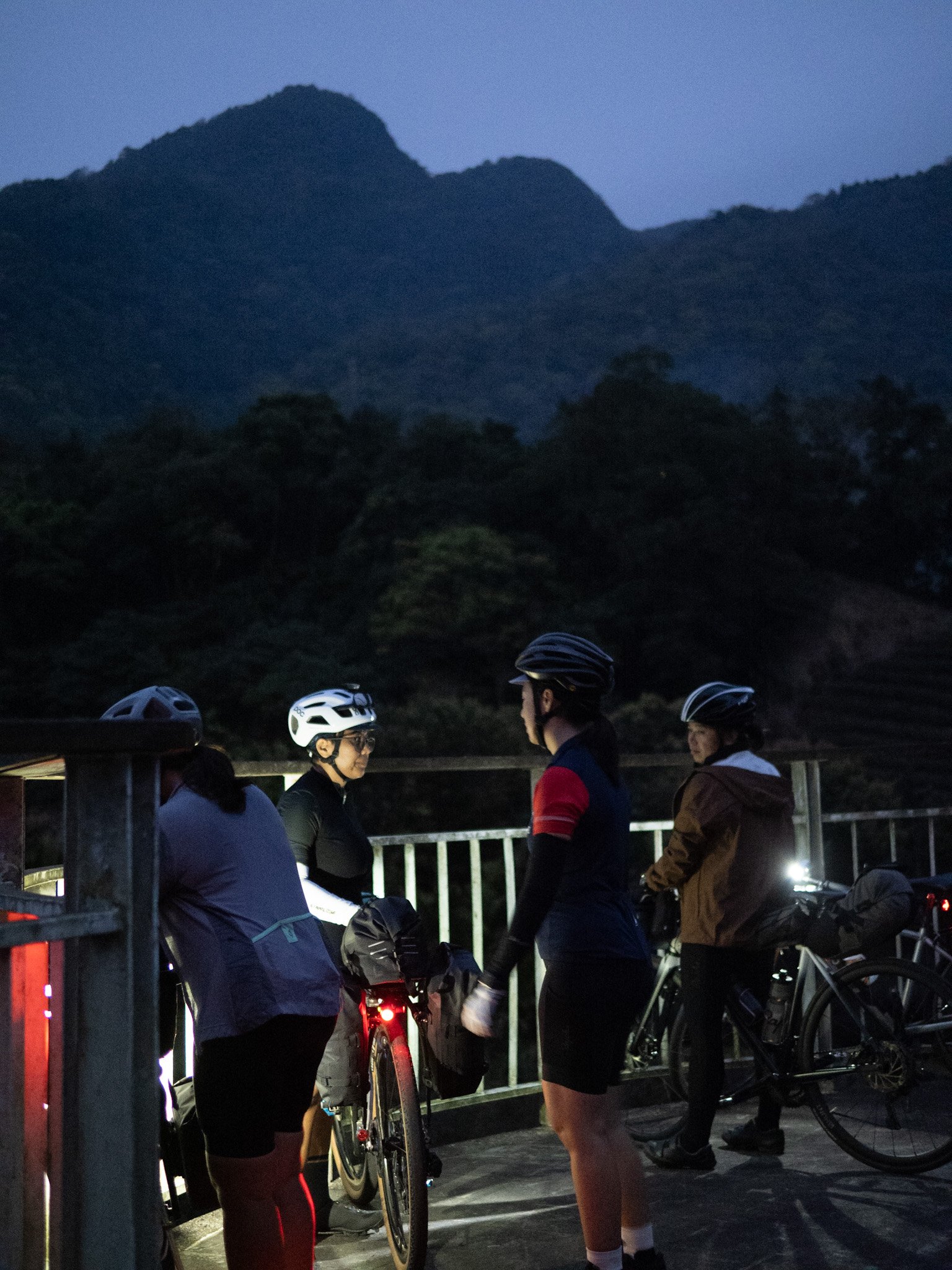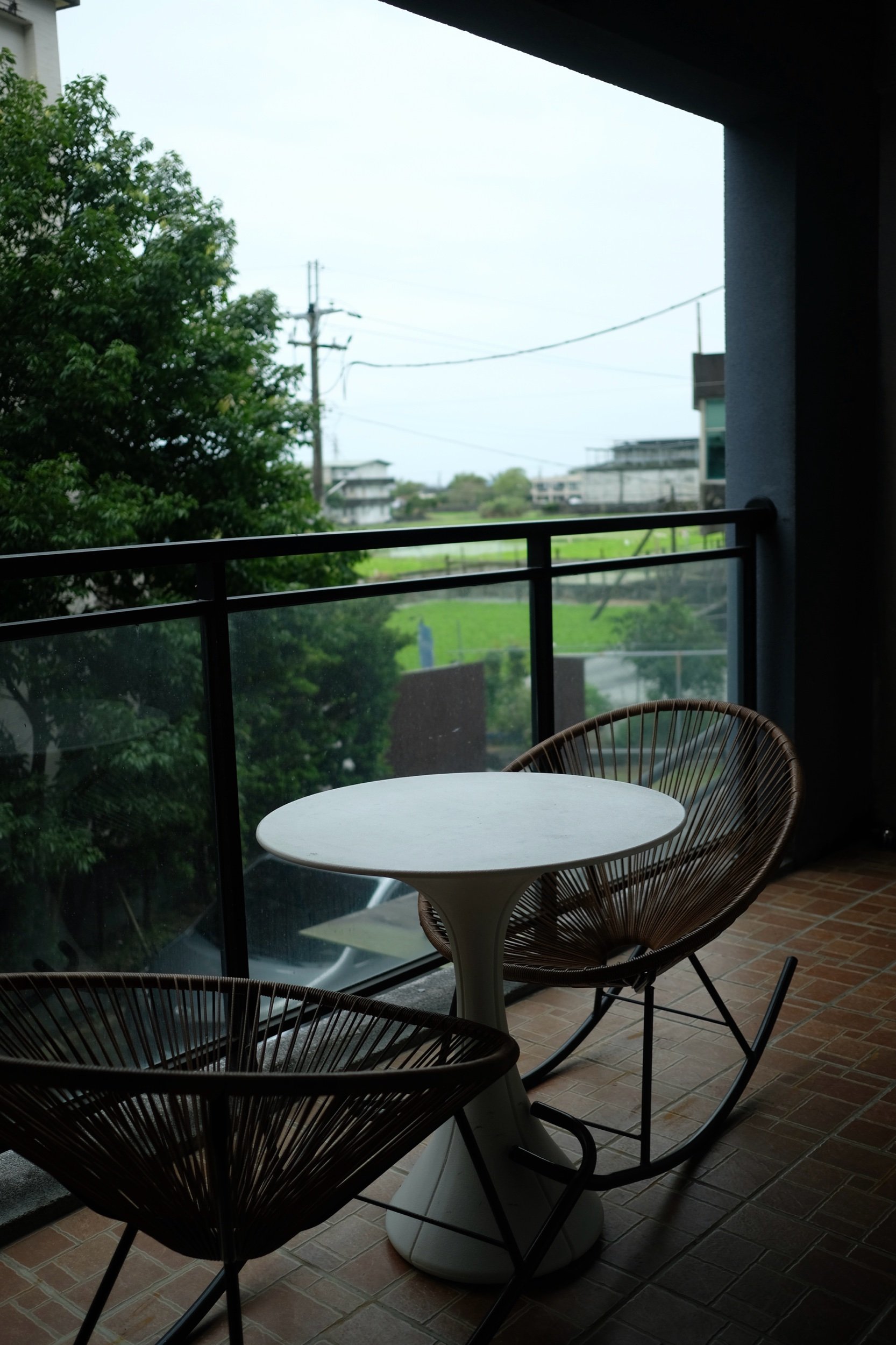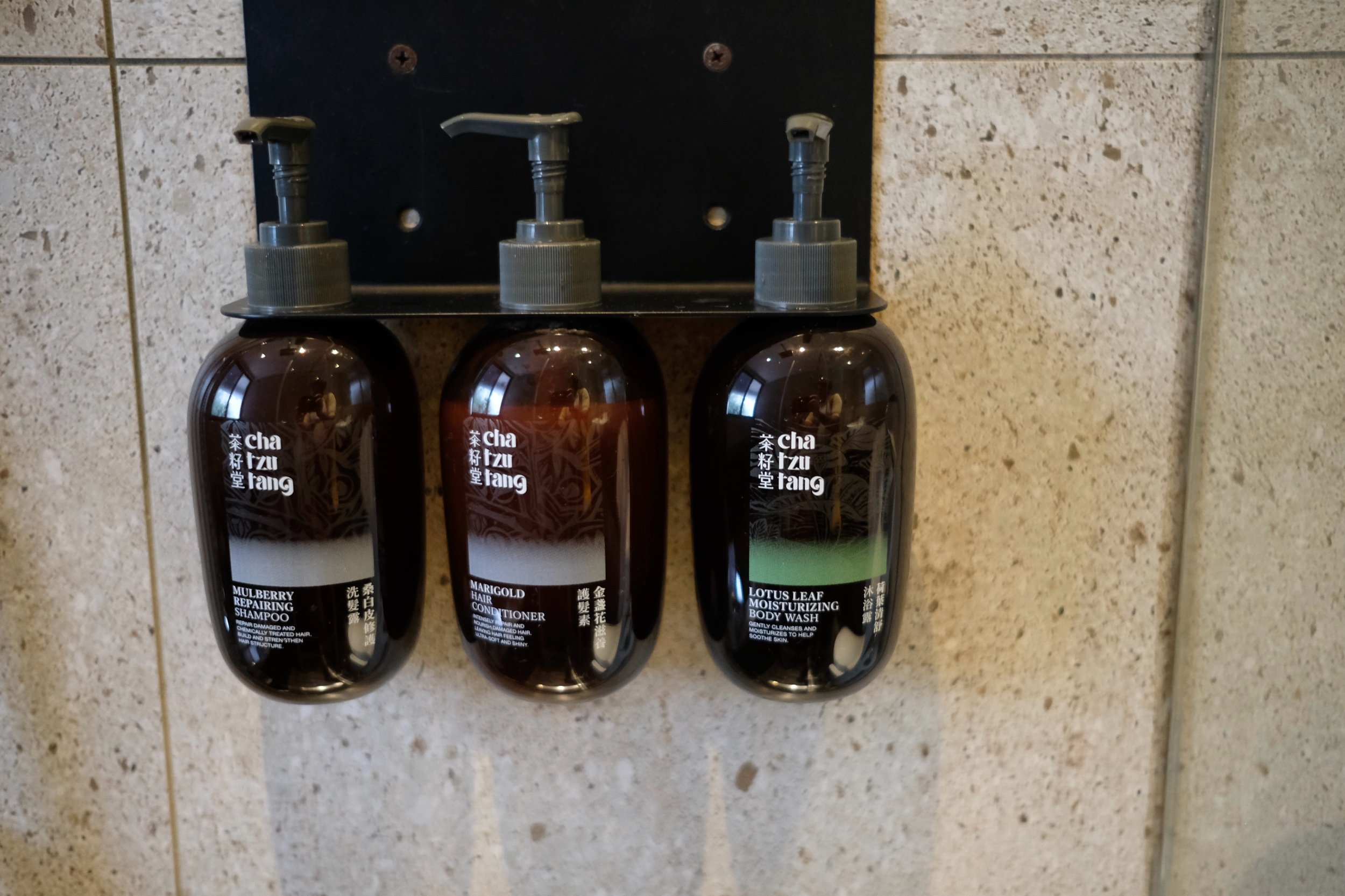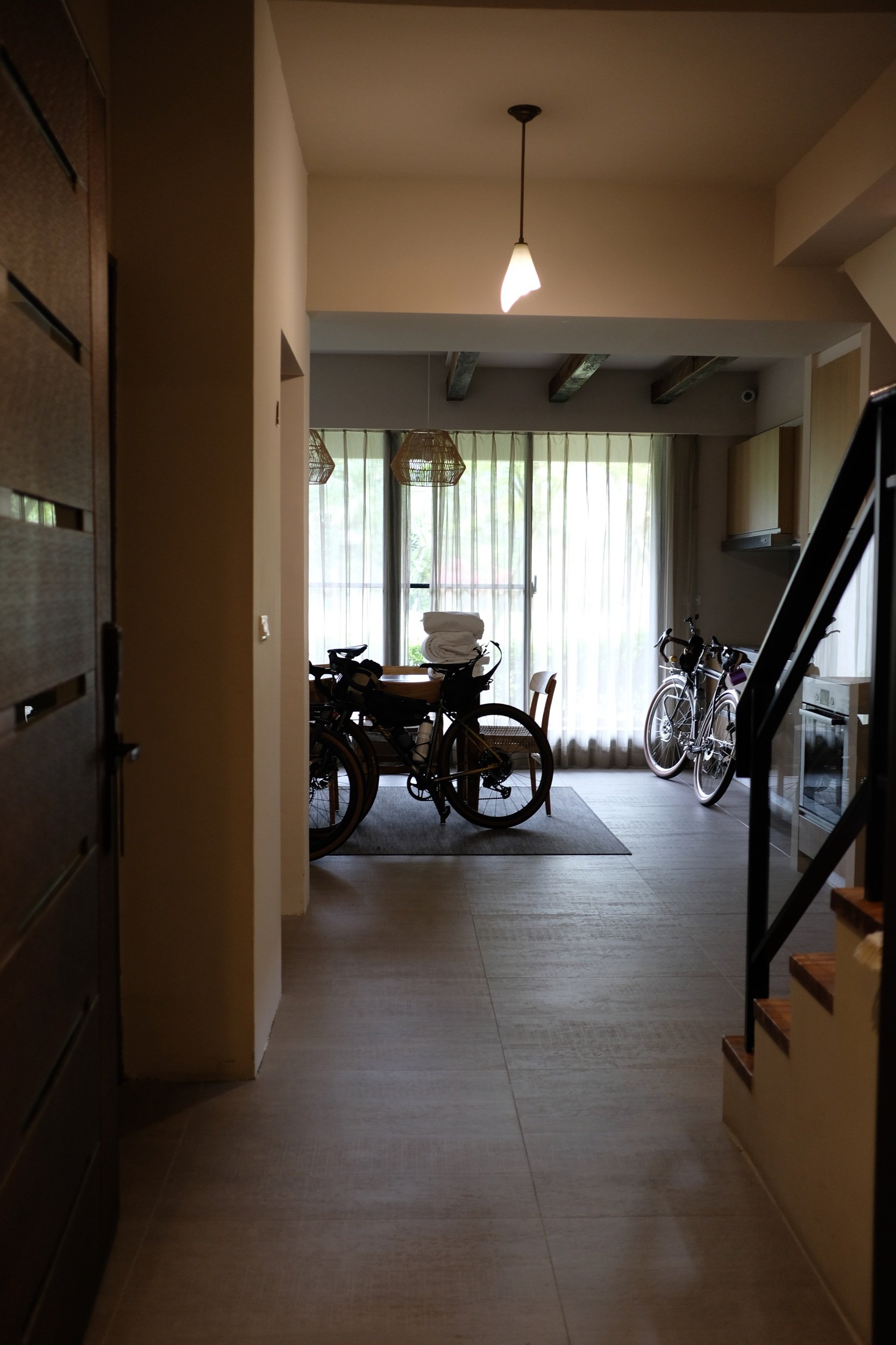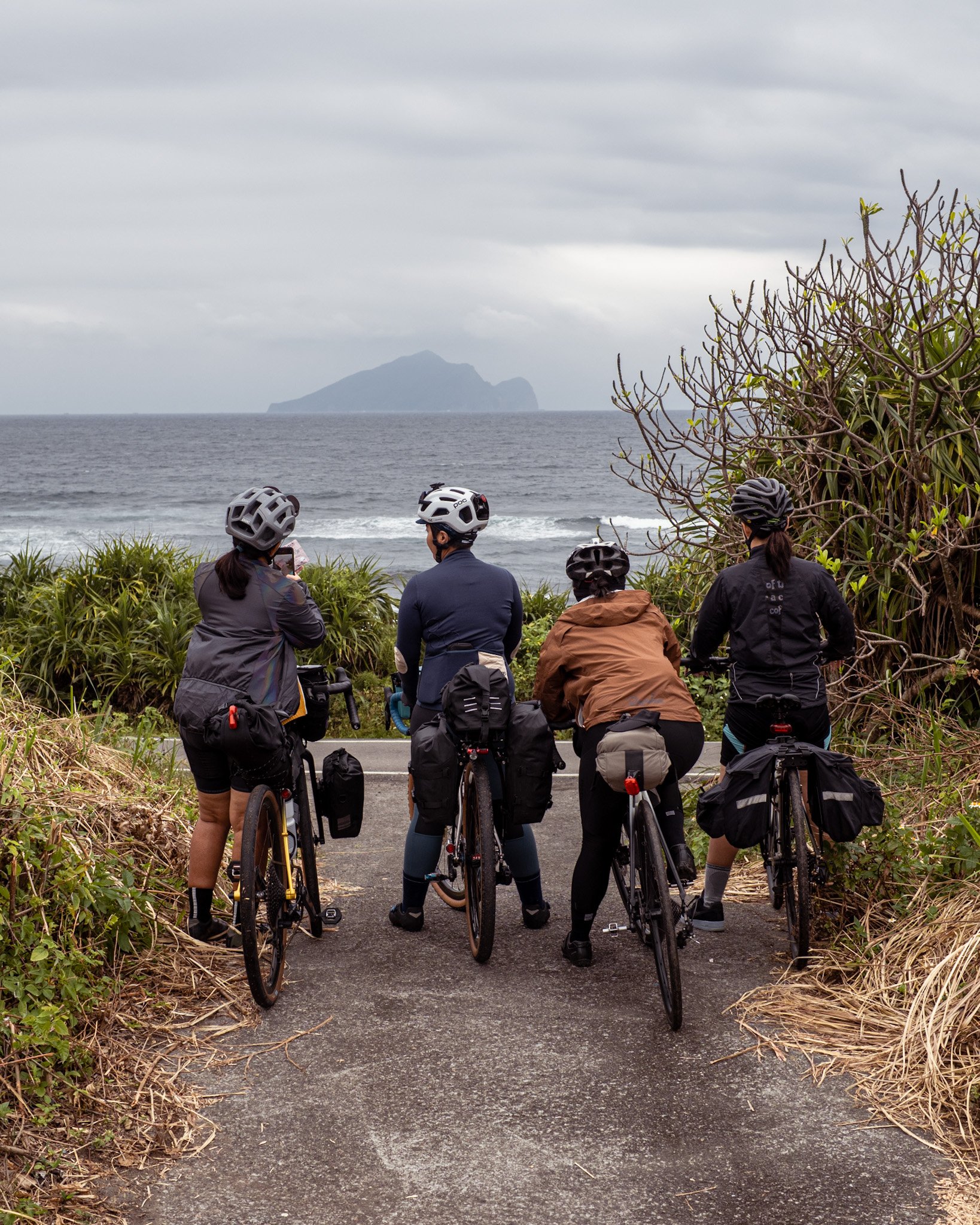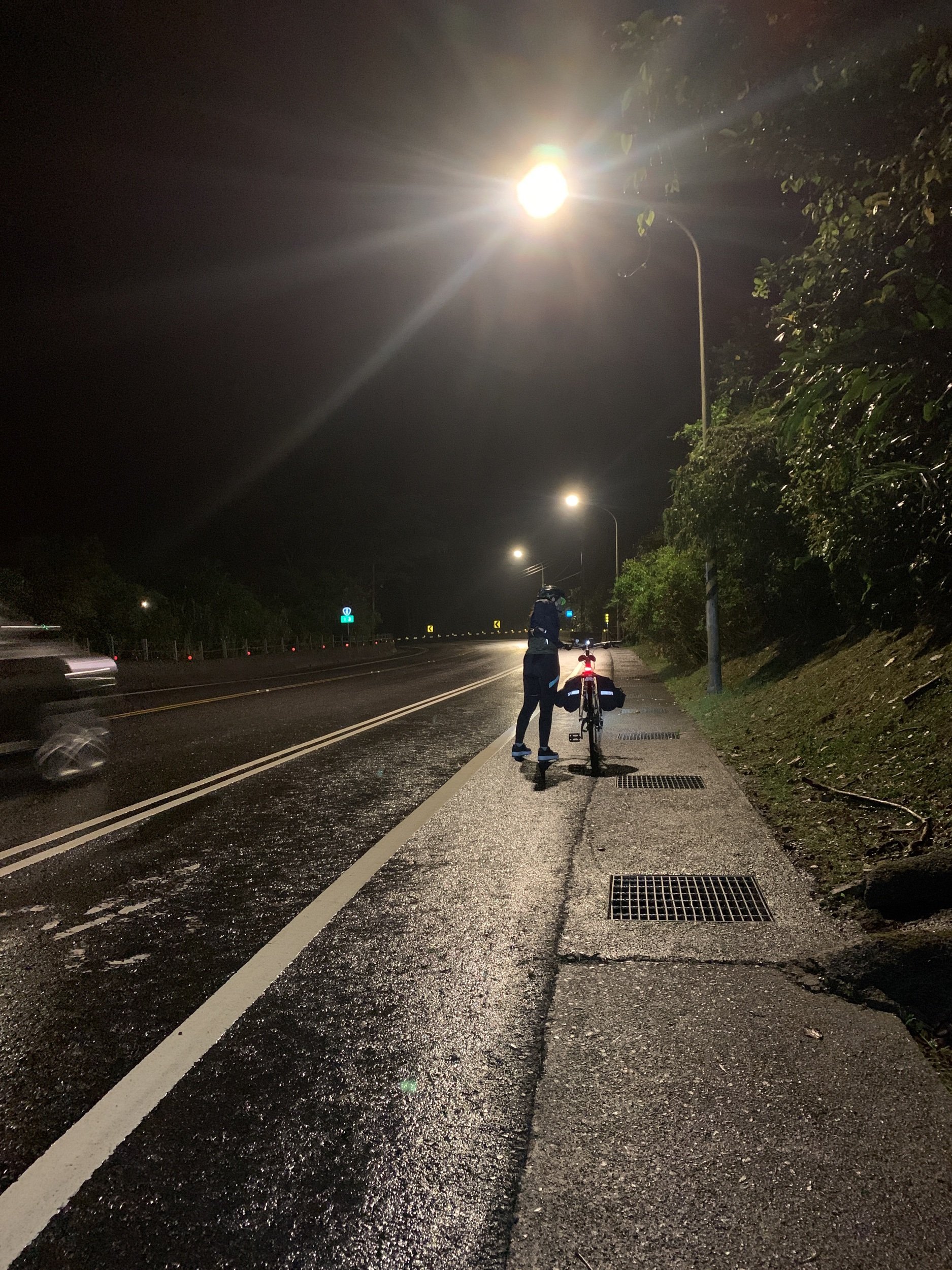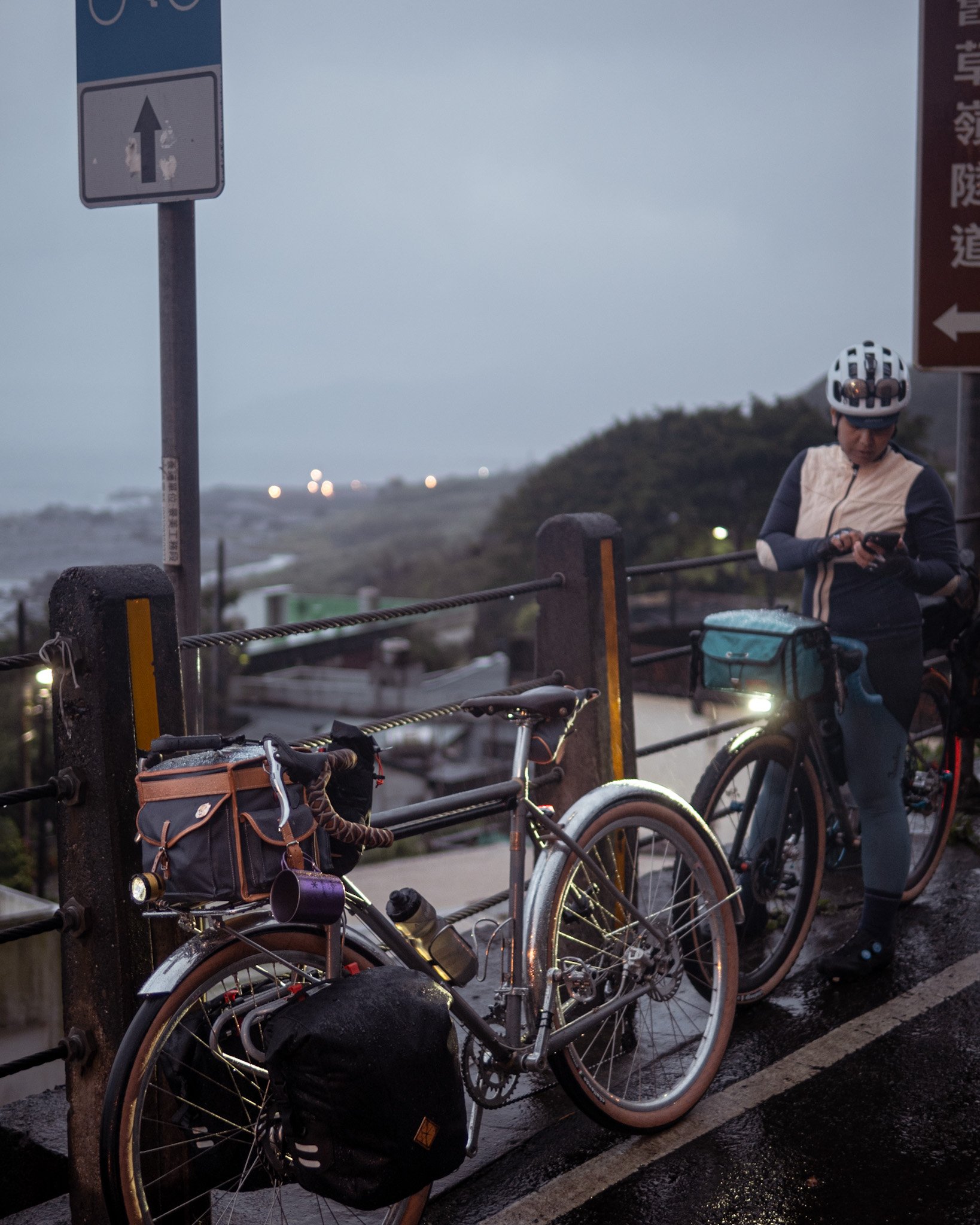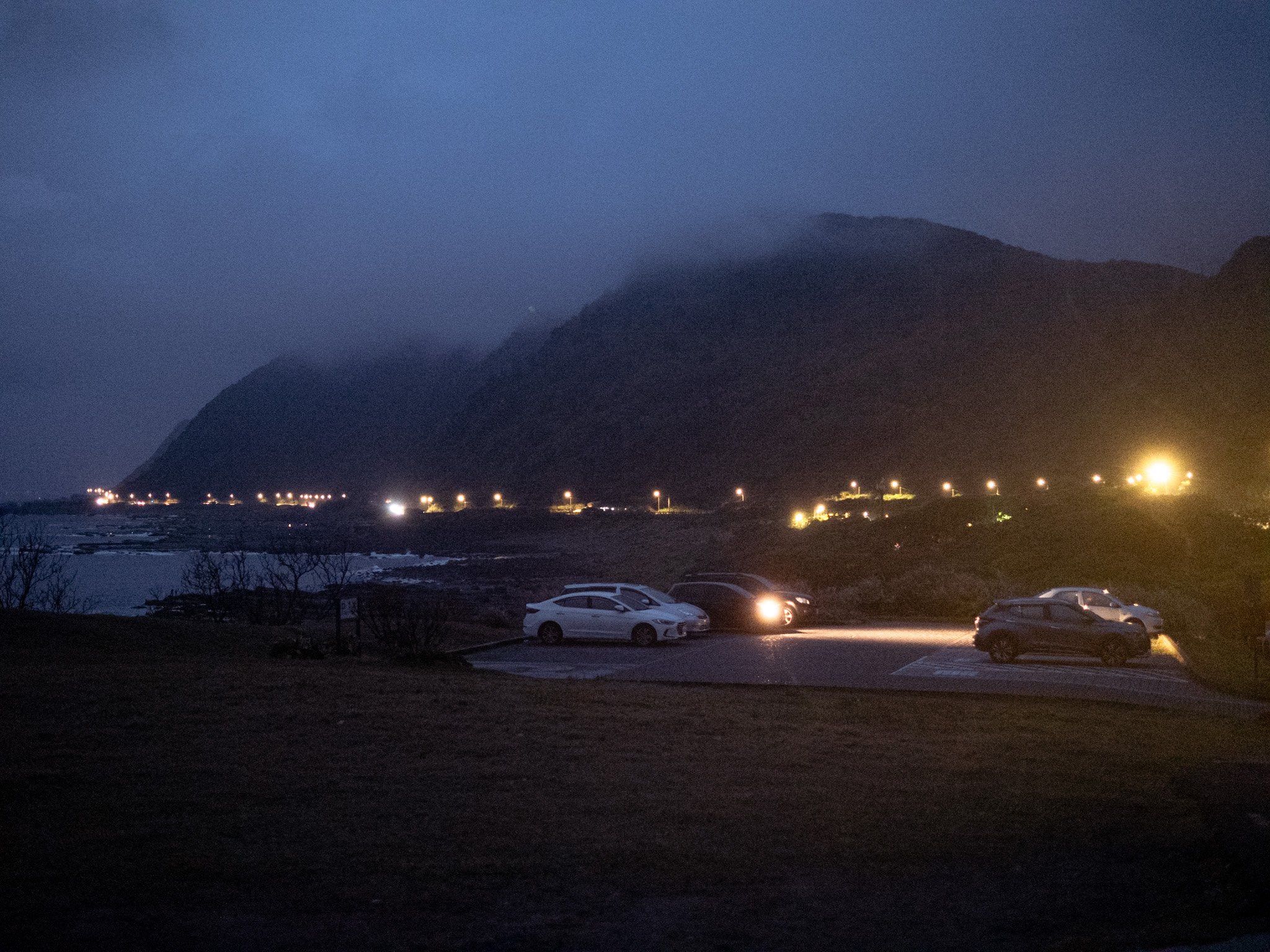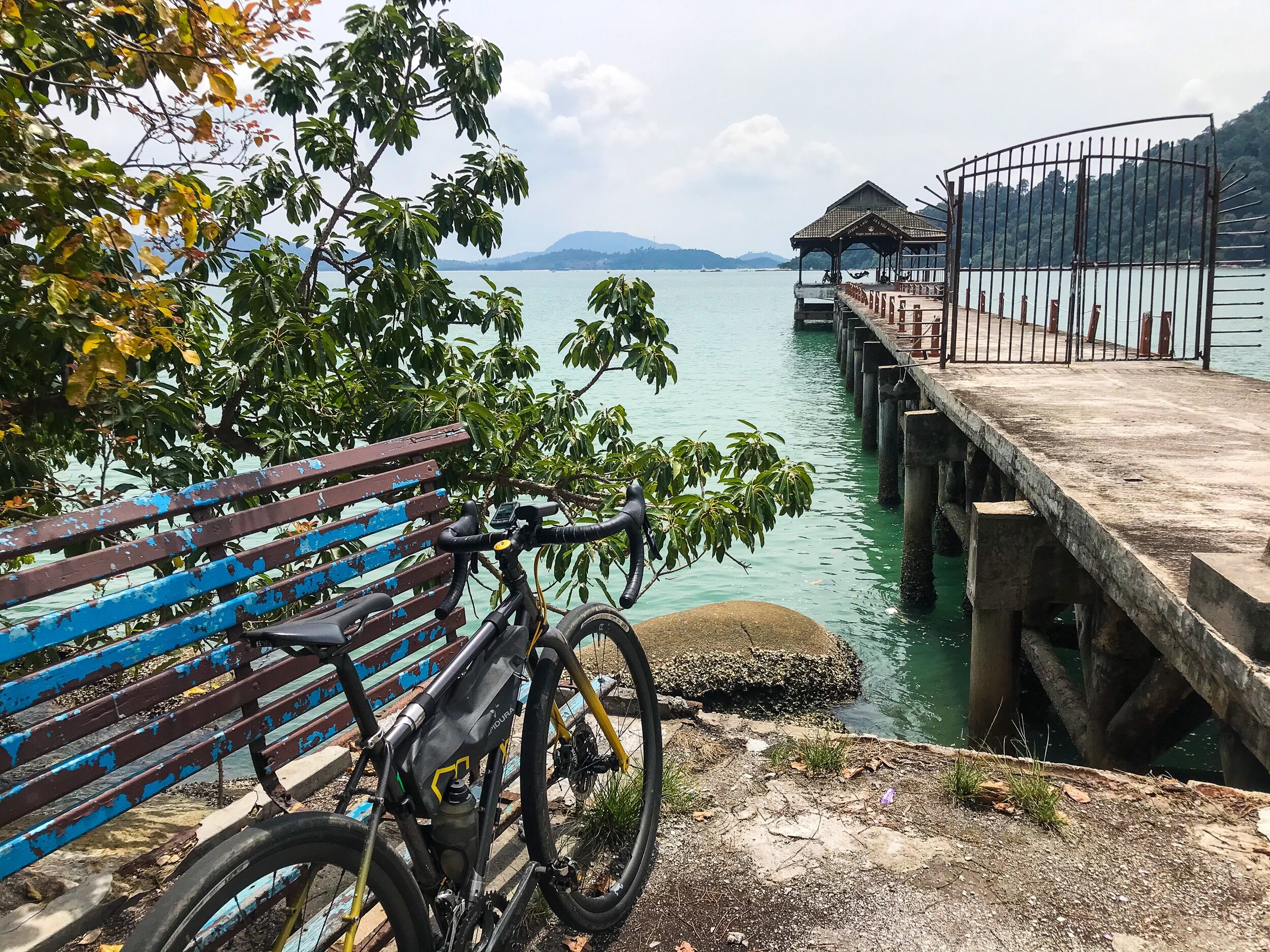Cycling Northeast Taiwan, part 1: Taipei to Jiaoxi, shifen and toucheng

Northeast Taiwan is home to the Northeast Coast National Scenic Area, which covers more than 17,000 hectares of land and sea. Although not very popular as a cycling tourism destination, the region offers a fantastic route for those who love climbing mountains and exploring coastlines.
Right after the opening of Taiwan’s borders the Bike Riding Tales crew got wind that Taipei Cycle Show was making a comeback for 2023. After a three year hiatus, Asia’s biggest bike expo was finally welcoming visitors once again, which hopefully provided a nice boost to the cycling industry that experienced quite a turbulent rollercoaster ride during the covid-19 pandemic. Despite having barely settled back into daily life since returning from our autumn tour of Shikoku 2022 and our subsequent Langkawi tour 2023, obviously Eka and myself could not resist returning to one of our favourite cycling countries. Maya and Treas agreed immediately after thoroughly enjoying our first Taiwan tour, while our other friend Fiona would be a last minute addition to the group several days before we departed.
We’d been to the bike expo twice already, namely Taipei Cycle Show 2017 and Taipei Cycle Show 2019, when we explored both Taipei and the East Rift Valley respectively. This time around we wanted to do a slightly different tour, which would have to be scheduled before the show. The last few days of the bike expo would coincide with the Ramadhan fasting month, so we’d have to get the short tour completed and return to Taipei before the show started. Could this be done in less than two weeks with the bike expo squeezed in as well? Definitely. With the right planning, of course.
Cycling Taiwan’s Northeast Coast National Scenic Area
The Northeast Coast National Scenic Area stretches from New Taipei City to Su'ao Township, from Juifans south to Yilan County. The area has several nature preserves both on land and at sea, and is an area famed for its natural beauty, including two of Taiwan’s best beaches nationwide. The area is also home to Yangmingshan Mountain, which is a peak that Eka had earmarked previously as one he needed to conquer one day. Our previous tour of the East Rift Valley in 2019 was predominantly flat or gentle rolling terrain at most, with a massive climb heading from Fulong to the mountaintop town of Jiufen.
This time around, our route would have a mixture of mountain scenery and coastal views, with a heavier emphasis on climbing. On paper the stats looked fairly do-able, but the elevation turned out to be concentrated in short climb segments, meaning the gradients hit double digits on many occasions. There were to be no rest days for us on this trip, since it was in essence a mini tour just like our first Taiwan tour in 2019. The whole route would be a loop that began and ended in Taipei, with no train travel breaking up the journey (with the exception of some unplanned train segments - we’ll go into this later lol).
Stage 1: Taipei to Jiaoxi - 84km, 1,200m elevation
Stage 2: Jiaoxi to Shifen - 74km, 590m elevation
Stage 3: Shifen to Badouzi - 26km, 220m elevation
Stage 4: Badouzi to Yangmingshan - 60km, 1,100m elevation
Stage 5: Yangmingshan to Taipei - 45km, 150m elevation
For all intents and purposes we recognise that the Bike Riding Tales gang will need to do a full tour in Taiwan in the future, since we still have not done the Formosa 900 round island route after several trips to the island, nor have we done anything longer than five days. All of our trips have been bundled with a visit to Taipei Cycle Show, and we’ve unfortunately not done a full trip to Taiwan purely for the purpose of touring.
we fully believe that Taiwan is one of those underrated cycling destinations in Asia, with many Malaysians yet to discover this beauty of an island.
STAGE 1: taipei to jiaoxi
Start Taipei
Finish Jiaoxi
Distance 84km
Climbing 1,200m
Grade Medium/Hard
Since this tour of Taiwan’s Northeast Coast National Scenic Area was a loop that began and ended in Taipei, our starting point was none other than Cho Hotel, situated in Ximending in Wanhua District. Our suitcases and luggage would be held in the storage room of the hotel, which has been elevated to our new favourite accommodation in the city. We later checked into an Airbnb after the tour, but Cho Hotel has a special place in our hearts and we will definitely choose it as our base of operations the next time we travel there.
As Taipei’s oldest district Wanhua has many historic buildings, including the iconic Bangka Lungshan Temple, which was our first pit stop along the first day’s journey. Built in 1738 by settlers form Fujian, it served as a place of worship and a gathering place for Chinese settlers. We had a breakfast of noodles nearby before heading out to the Taipei bike lanes; an enjoyable ride considering it was a sunny day and the spring flowers had bloomed along the riverside parks. Heading southeast, we soon crossed into Xindian District in New Taipei City, which would mark the end of the flat part of our route and our entrypoint into the northern end of the Central Mountain Range.
There is some great hiking to be done in Xindian District, with many mountain trails, but for traveling cyclists this meant some pretty decent climbs as the road snakes through the countryside. After a brief stop at Family Mart for a small snack to power up and a toilet break, we soon began to climb the first peak. The gradients ranged from anything between 2% to 7% up to the first peak at the 33km mark, with 5% being the most common all along the climb spanning approximately 16km. We took a much needed break at Helen Cafe since it was highly recommended by our Taiwanese friends owing to its lookout point al fresco dining, but we arrived too late for lunch and had to make do with a waffle each after a lengthy wait because they ran out of waffle batter. Its worth nothing that the cafe doesn’t really have anything substantial to eat beyond toast either.
A little more climbing later we were finally rewarded with a descent to Pinglin Town near sunset, but by then too late for an afternoon tea break. This was quite a shame, since Pinglin District is famous as a tea producing region, particularly baozhong or pouchong tea, which is only grown in Fujian, China, and Pinglin, Taiwan. If anyone tells you there is nothing in Pinglin they are either pulling your leg or don’t quite realise how important of a place it is to Taiwan’s tea culture. The tea grown here is unique in flavour and scent, and is often called ‘flower tea’ because of its fragrant smell. 80% of Pinglin’s residents are tea farmers or are involved in the tea industry in some way, and the Pinglin Tea Musem is actually the world’s largest tea museum.
Disappointed but not defeated, we made another snack and toilet stop at the local Family Mart, before heading out to tackle the next peak. Along the way we caught a glimpse of tea plantations and riverside campsites, as the sun began to set. While not as tall as the first and third peak on our route for the day, the second peak was fairly gruelling as it was a short but intense climb with double digit gradients, going up to 20%+. At this point we all got off our bikes to push, often laughing hysterically at the insane steepness of the twists and turns of the mountain road through the quiet villages.
At about 55km we reached the peak and enjoyed a brief 3km descent, then approached the base of our third peak and final climb for the day. The final climb was the most gentle of the three with gradients averaging around 3.5%, but tired legs and a lack of proper nutrition throughout the day weighed heavily on us by then. We rode on in pitch black conditions, save for the street lamps illuminating the mountain road, the group spreading out according to fitness and remaining energy levels. Reaching the third peak meant we’d covered 66km in total, after which we enjoyed a long and winding descent to Jiaoxi that included several hairpin turns in the dark. As we continued down we enjoyed the nighttime view of the Jiaoxi and Toucheng Townships of Yilan County and the coast beyond. Were it still daylight, we would have also been able to the sea and Turtle Island too.
The end of the climb signalled our entry into Jiaoxi, a hotspring resort town that has become very popular owing to its close proximity to Taipei city. We had managed to find Onsense, a lovely villa off the noisy main street, tucked away in a residential area a short distance away. It was a spacious, clean and well maintained accommodation resembling serviced apartments, but with full service like breakfast included and a private onsen bath for each villa. After climbing some 1,200m from Taipei, we sank into the bath blissfully later that night with a bowl of mutton noodles swimming around happily in our bellies. What a great end to the first day of our tour during which nothing went according to plan.
STAGE 2: jiaoxi to shifen
Start Jiaoxi
Finish Shifen
Distance 74km
Climbing 590m
Grade Medium
Stage 2 was meant to be an active recovery day of medium distance and much less elevation, giving the group a chance to recover from the first day’s exertions. However, this proved not to be the case for myself. I woke up at 4am for the sole purpose of throwing up the contents of my stomache, with anything remaining following suit right before breakfast. Either it was a delayed build up of lactic acid or a reaction to a new fitness supplement, we may never know. What was certain - it wasn’t dinner that didn’t agree with me, since we all ate similar dishes at the same stall the night before.
Either way, as we rode out of the villa in overcast conditions it became apparent that I would not last the whole journey. We made a quick pitstop at the main temple in town to see a very lively prayer ceremony, before crossing the road to a small cafe for everyone’s morning coffee. I sat in the parking lot with the bikes contemplating the follies of my failed doping attempt and generally feeling miserable. Downing some rehydration salts after my small breakfast nibbles didn’t really do much to reenergise myself, and the ride out past paddy fields to the seaside bike lane felt painfully slow.
We soon reached the bike lane and followed its beautifully smooth tarmac to Toucheng, the coastal headwinds doing their best to ensure I had the ultimate struggle just to keep pedaling. We found the turn-off to the seaside town, which was our checkpoint for an overnight stay before the climb to Jiufen in 2019. Translating to “first town” in Chinese, Toucheng is the first settlement in Yilan from the 1700s, becoming the economic hub of Yilan until two nearby harbours silted in. Today Toucheng has become a major tourist area and a popular surfing location.
We all sat down to a bowl of seafood ramen, at which point it was quite clear that a train ride to the next town was necessary for myself, with Fiona and Treas opting to jump onto the train too. Fiona wasn’t keen on riding in wet conditions since rain was imminent that afternoon, while Treas was nursing a small muscle pull after the first day’s three mountain peak climbs. So off we went to the train station after lunch, which I had no appetite to finish anyway. While the lunch was fairly tasty, vomitting and purging ensured my hunger was tempered by a bitter taste to everything I attempted to swallow.
The good news was that the larger Toucheng area has three railway stations, more than any other townships in Taiwan. The main one built in the township i.e. Toucheng station dates all the way back to 1920, and was just a short ride away from our lunch spot. We also knew that there was a train station in our destination for the night, the agricultural town of Shifen. However, the bad news was that the direct train to Shifen doesn’t allow full bicycles on board. As an alternative, we would have to take the train to Ruifang and cycle the remaining less than 20km into town.
Not all trains in Taiwan will allow full bicycles on board, some only allow bicycles in rinko bags, some don’t at all. Check Taiwan Railways’ website for specific details and timing.
As the train went on its journey we could enjoy views of the rocky coastline, where the threat of rain finally materialised. Remaining nice and dry inside the train carriage, we wondered how Eka and Maya were getting along on the bikes. It didn’t take long for us to find out, as half an hour into our train journey they appeared on the platform to wave us goodbye. They’d somehow snuck onto the platform while taking shelter from the rain, which started as an ominous gathering of misty clouds that gave way to a sprinkle before gathering strength as they continued along the seaside road. The carriage doors soon closed and the train pulled out of the platform, leaving Eka and Maya waving goodbye ruefully, looking like two drowned rats.
From there we had another half an hour left but opted to get off the train a little earlier at Shuangxi station, which would shorten our route by almost half to 10km. It was dark by the time we arrived but it looked like we had escaped most of the rain. There were some intense long stretches of rolling climbs on the way including a long tunnel, with gradients ranging between an easy 2% to 8%, a pretty challenging final stretch for my already exhausted legs and a body that had almost no fuel since the previous night. Still, we made it there within two hours, when the last shop selling tourist trinkets was the only one open, albeit closing shop for the night.
I’d worried about Maya and Eka not being able to eat when they finally arrived as the Family Mart where we were eating a makeshift dinner closed at 10pm, but thankfully they had a serendipitious burger joint stop along the way at the little seaside town of Fulong. They’d enjoyed views of the layers of sea mist and rain, which gave the jagged coastline a dreamy ethereal look, and only began heading inland from their dinner spot. The rolling terrain from there was fairly challenging after the full day of climbing the mountain, and it was only at 10.30pm that the whole group rendezvoused at our accommodation for the night, a local homestay with a mix of modern and Japanese style tatami rooms. After a shower, we all fell asleep with a great feeling of relief that Stage 3 would be much gentler than the first two days of the tour.
Continue to part 2 of our tour, where we show you the Yangmingshan mountain climbing loop!

